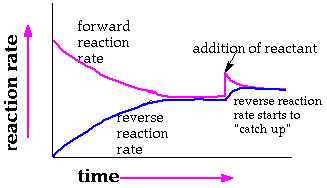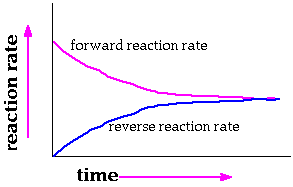


|
Le Chatelier's Principle:
What Happens to an Equilibrium When Conditions Change
|
|
Le Chatelier's
Principle:
|
|
|
When a stress
is applied to a system at equilibrium the system will adjust to
relieve the stress.
|
|
| Stresses
applied to chemical equilibrium systems: These
changes are initial ones made to a system already at equilibrium. The
amounts of reactant and product must follow the equilibrium constant for
the reaction. |
- 1. An increase in concentration on one side of an equation favors or drives the reaction to the opposite side. adding reactants favors products
- adding products favors reactants
|
2. An increase in temperature favors or drives an endothermic reaction forward to products. |
3. An increase in temperature drives an exothermic reaction backwards to reactants. |
4. An increase in pressure drives a reaction toward the side with fewer molecules (moles) of gas. Increased pressure "forces" the reaction into a smaller volume. The gas volume is smaller with fewer gas molecules. |
5. Adding a catalyst does not alter the relative amounts of reactant and product. Forward reaction happens more easily and so does the reverse reaction. Equilibrium is only reached faster. |
|
Le Chatelier's
Principle:
|
| The equilibrium
system is balanced in terms of the forward and reverse reaction rates.
Any "stress" that alters one of these rates makes the system "shift" .
The "shift" occurs so that the two rates eventually equalize. The reaction
rate for the forward reaction is typically high because the reactants
are present in the mixture at the start. There normally are no products
around at the start of a reaction. The reverse reaction will become more
important as the amanita of product increases.
|
Increasing
the concentration of a substance in the equilibrium mixture creates a
temporary increase the reaction rate on that side of the equilibrium.
The illustration shows the effect of additional reactant on the forward
rate. The forward reaction rate "jumps". The reverse reaction rate gradually
climbs up to reestablish balance. The new equilibrium has an increased
amount of product. The system shifted to relieve the stress. Addition
of a reactant has resulted in an increase in the amount of product.
 The equilibrium system
is balanced in terms of the forward and reverse reaction rates. Any "stress"
that alters one of these rates makes the system "shift" . The "shift"
occurs so that the two rates gradually come back to be equality.
The equilibrium system
is balanced in terms of the forward and reverse reaction rates. Any "stress"
that alters one of these rates makes the system "shift" . The "shift"
occurs so that the two rates gradually come back to be equality. |
|
An equilibrium can
be viewed like a balance beam. The reactants are on the right hand side
and the products are on the left hand side. When the system is balanced
the forward and reverse rates are equal. The picture shows an equilibrium
where K = 1. The balance arms are equal length.
|
|
If reactants are
added to the system the "balance" will be lost temporarily. The balance
can be recovered when the system forms more product to bring back an
equilibrium condition.
|
|
The added reactants
cause an increase in the amount of products. The reactants will be converted
to form the additional product.
|
| The
added reactants cause an increase in the amount of products. |
|
Let's look at the
reaction between hydrogen and carbon monoxide. If the reaction is at
equilibrium and we add more CO(g) to the mixture, then the forward reaction
will occur faster than the reverse. More product will form and not be
depleted because the reverse rate is the "slow" one from the earlier
equilibrium. Gradually the reverse rate will increase because of the
new products. The forward rate will gradually decrease as excess reactant
is consumed. The concentration of products will continue to rise until
the reverse rate and forward rates equalize. The amount of CH3OH
, methanol, will rise.
1 CO(g) + 2 H2
(g) <---> CH3OH (g)
There is a MISLEADING
statement in the text. All of the excess CO is not used up. The definition
of excess is at issue. Some of the added CO will be converted to products,
but not all.
|
The equilibrium
can be recovered by the formation of new methanol, CH3OH(g)
The
equilibrium shifts to relieve the stress of added reactant CO.
|
|
What
would happen if product methanol was added to the equilibrium?
|
The
equilibrium can be recovered by the formation of CO and H2.

The
addition of a substance to one side of an equilibrium results in an
increase in materials on the opposite side.
|
|
What
would happen if product methanol was removed from the equilibrium?
The decrease in
methanol would cause CO and H2 to form methanol to replace
the amount removed. The forward rate would temporarily be greater than
the reverse rate. The formation of methanol would occur faster than
its decomposition. The amount of product would go up to replace what
was removed.
|
|
Effect of pressure
changes:
|
| Usually
only reactions involving gases are altered by pressure changes. Gas pressure
results from gas molecules banging against the walls of the container.
If you handle gases you know that gas molecules "seek" low pressure. Compressed
gas "escapes" high pressure in a balloon or out of a tire valve stem.
Low pressure also goes with fewer molecules of gas. If
the pressure is on an equilibrium is increased the system will shift to
lower the pressure. The lower number of gas molecules uses less space
or volume. This favors the side of the reaction with fewer gas molecules.
|
|
What
would happen to the
equilibrium if the pressure was raised?
1
CO(g) + 2 H2 (g) <---> CH3OH (g)
The reactants side
has three molecules of gas while the products side has only one molecule
of gas. Increasing the pressure favors the side with lass volume. The
products are favored because the fewer gas molecules occupy less volume.
The forward rate
would be greater than the reverse rate. The formation of methanol would
occur faster than its decomposition.
1
CO(g) + 2 H2 (g) <---> CH3OH (g)
|
|
What
would happen to the 1 C(s) + 2 H2 (g) <---> CH4(g)
equilibrium if the pressure was raised?
The reactants side
has two molecules of gas while the products side has only one molecule
of gas. Increasing the pressure favors the products side with less volume.
The forward rate
would be greater than the reverse rate. The formation of methane would
occur faster than its decomposition.
|
|
What
would happen to the 1 CaCO3(s) <---> CaO(s) + CO2(g)
equilibrium if the pressure was raised?
The reactants side
has no molecules of gas while the products side has only one molecule
of gas. Increasing the pressure favors the reactants side with less
volume. The reverse rate would be greater than the forward rate. The
formation of CaCO3(s) would occur faster than its decomposition.
|
|
What
would happen to the N2 (g)
) + O 2(g)
<---> 2 NO(g) equilibrium if the pressure was raised?
Both sides of the
equation have two molecules of gas. The pressure increase would cause
no change.
|
|
Effect of temperature
changes:
|
|
Temperature changes
can shift an equilibrium balance just as concentration changes. Raising
the temperature for an exothermic reaction favors reactants.
|
|
Raising the temperature
for an endothermic reaction favors formation of products.
|
|
What
happens to the ammonia equilibrium if the temperature is raised?

3 H
2 (g)
+ 1 N 2(g) <---> 2 NH
3 (g) + heat
|
|
The equilibrium
balance can be reestablished if the amount of reactants increase. Raising
the temperature for the ammonia reaction favors the reverse reaction
and the formation of reactants.
|
- 1.
An increase in concentration on one side of an equation favors
or drives the reaction to the opposite side.
- adding
reactants favors products
- adding
products favors reactants
|
|
2.
An increase in temperature favors or drives an endothermic reaction
forward to products.
|
|
3.
An increase in temperature drives an exothermic reaction backwards to
reactants.
|
|
4.
An increase in pressure drives a reaction toward the side with fewer
molecules (moles) of gas. Increased pressure "forces" the reaction into
a smaller volume. The gas volume is smaller with fewer gas molecules.
|
|
5.
Adding a catalyst does not alter the relative
amounts of reactant and product. Forward reaction happens more easily
and so does the reverse reaction. Equilibrium is only reached faster.
|
|
Online
Introductory Chemistry
|
|
Dr.
Walt Volland, All rights reserved, 1998-2004
|
|
last
modified April 2, 2005
|










![]()
